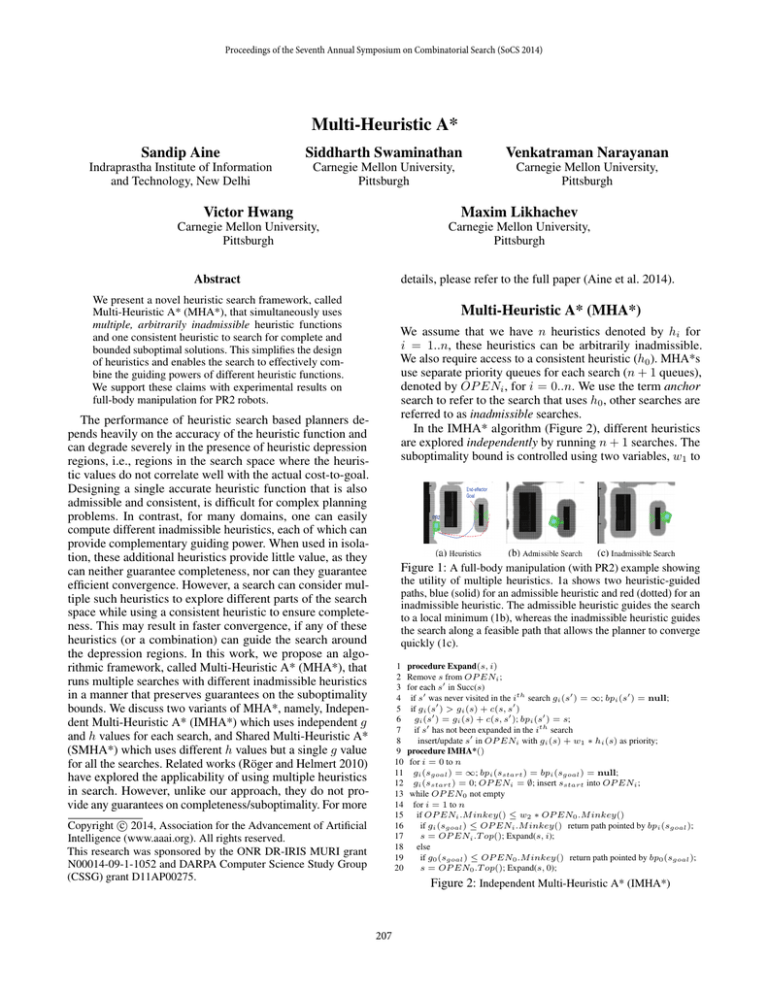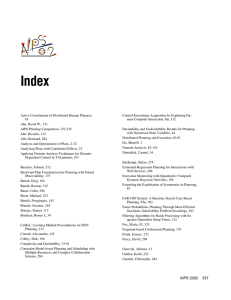
Proceedings of the Seventh Annual Symposium on Combinatorial Search (SoCS 2014)
Multi-Heuristic A*
Sandip Aine
Siddharth Swaminathan
Venkatraman Narayanan
Indraprastha Institute of Information
and Technology, New Delhi
Carnegie Mellon University,
Pittsburgh
Carnegie Mellon University,
Pittsburgh
Victor Hwang
Maxim Likhachev
Carnegie Mellon University,
Pittsburgh
Carnegie Mellon University,
Pittsburgh
Abstract
details, please refer to the full paper (Aine et al. 2014).
We present a novel heuristic search framework, called
Multi-Heuristic A* (MHA*), that simultaneously uses
multiple, arbitrarily inadmissible heuristic functions
and one consistent heuristic to search for complete and
bounded suboptimal solutions. This simplifies the design
of heuristics and enables the search to effectively combine the guiding powers of different heuristic functions.
We support these claims with experimental results on
full-body manipulation for PR2 robots.
Multi-Heuristic A* (MHA*)
We assume that we have n heuristics denoted by hi for
i = 1..n, these heuristics can be arbitrarily inadmissible.
We also require access to a consistent heuristic (h0 ). MHA*s
use separate priority queues for each search (n + 1 queues),
denoted by OP ENi , for i = 0..n. We use the term anchor
search to refer to the search that uses h0 , other searches are
referred to as inadmissible searches.
In the IMHA* algorithm (Figure 2), different heuristics
are explored independently by running n + 1 searches. The
suboptimality bound is controlled using two variables, w1 to
The performance of heuristic search based planners depends heavily on the accuracy of the heuristic function and
can degrade severely in the presence of heuristic depression
regions, i.e., regions in the search space where the heuristic values do not correlate well with the actual cost-to-goal.
Designing a single accurate heuristic function that is also
admissible and consistent, is difficult for complex planning
problems. In contrast, for many domains, one can easily
compute different inadmissible heuristics, each of which can
provide complementary guiding power. When used in isolation, these additional heuristics provide little value, as they
can neither guarantee completeness, nor can they guarantee
efficient convergence. However, a search can consider multiple such heuristics to explore different parts of the search
space while using a consistent heuristic to ensure completeness. This may result in faster convergence, if any of these
heuristics (or a combination) can guide the search around
the depression regions. In this work, we propose an algorithmic framework, called Multi-Heuristic A* (MHA*), that
runs multiple searches with different inadmissible heuristics
in a manner that preserves guarantees on the suboptimality
bounds. We discuss two variants of MHA*, namely, Independent Multi-Heuristic A* (IMHA*) which uses independent g
and h values for each search, and Shared Multi-Heuristic A*
(SMHA*) which uses different h values but a single g value
for all the searches. Related works (Röger and Helmert 2010)
have explored the applicability of using multiple heuristics
in search. However, unlike our approach, they do not provide any guarantees on completeness/suboptimality. For more
Figure 1: A full-body manipulation (with PR2) example showing
the utility of multiple heuristics. 1a shows two heuristic-guided
paths, blue (solid) for an admissible heuristic and red (dotted) for an
inadmissible heuristic. The admissible heuristic guides the search
to a local minimum (1b), whereas the inadmissible heuristic guides
the search along a feasible path that allows the planner to converge
quickly (1c).
1
2
3
4
5
6
7
8
9
10
11
12
13
14
15
16
17
18
19
20
c 2014, Association for the Advancement of Artificial
Copyright Intelligence (www.aaai.org). All rights reserved.
This research was sponsored by the ONR DR-IRIS MURI grant
N00014-09-1-1052 and DARPA Computer Science Study Group
(CSSG) grant D11AP00275.
procedure Expand(s, i)
Remove s from OP ENi ;
for each s0 in Succ(s)
if s0 was never visited in the ith search gi (s0 ) = ∞; bpi (s0 ) = null;
if gi (s0 ) > gi (s) + c(s, s0 )
gi (s0 ) = gi (s) + c(s, s0 ); bpi (s0 ) = s;
if s0 has not been expanded in the ith search
insert/update s0 in OP ENi with gi (s) + w1 ∗ hi (s) as priority;
procedure IMHA*()
for i = 0 to n
gi (sgoal ) = ∞; bpi (sstart ) = bpi (sgoal ) = null;
gi (sstart ) = 0; OP ENi = ∅; insert sstart into OP ENi ;
while OP EN0 not empty
for i = 1 to n
if OP ENi .M inkey() ≤ w2 ∗ OP EN0 .M inkey()
if gi (sgoal ) ≤ OP ENi .M inkey() return path pointed by bpi (sgoal );
s = OP ENi .T op(); Expand(s, i);
else
if g0 (sgoal ) ≤ OP EN0 .M inkey() return path pointed by bp0 (sgoal );
s = OP EN0 .T op(); Expand(s, 0);
Figure 2: Independent Multi-Heuristic A* (IMHA*)
207
1
2
3
4
5
6
7
8
9
10
11
12
13
14
15
16
17
18
19
20
21
procedure Expand(s)
Remove s from OP ENi ∀i = 0..n;
for each s0 in Succ(s)
if s0 was never visited g(s0 ) = ∞; bp(s0 ) = null;
if g(s0 ) > g(s) + c(s, s0 )
g(s0 ) = g(s) + c(s, s0 ); bp(s0 ) = s;
if s0 has not been expanded in the anchor search
insert/update s0 in OP EN0 with g(s) + w1 ∗ h0 (s) as priority;
if s0 has not been expanded in any inadmissible search
insert/update s0 in OP ENi with g(s) + w1 ∗ hi (s) as priority, ∀i = 1..n;
procedure SMHA*()
g(sgoal ) = ∞; bp(sstart ) = bp(sgoal ) = null; g(sstart ) = 0;
for i = 0 to n OP ENi = ∅; insert sstart into OP ENi ;
while OP EN0 not empty
for i = 1 to n
if OP ENi .M inkey() ≤ w2 ∗ OP EN0 .M inkey()
if g(sgoal ) ≤ OP ENi .M inkey() return path pointed by bp(sgoal );
s = OP ENi .T op(); Expand(s);
else
if g(sgoal ) ≤ OP EN0 .M inkey() return path pointed by bp(sgoal );
s = OP EN0 .T op(); Expand(s);
Figure 4: Example of kitchen environments used for our experiments.
SR
SE
RT
SC
WA* MHGBFS MPWA* EES IMHA* SMHA*
31%
76%
36% 27% 70%
81%
1.08
0.78
3.84 1.54 1.58
1.0
0.99
0.91
2.82 1.54 1.41
1.0
0.95
1.57
0.97 0.93 1.09
1.0
Table 1: Comparison between WA*, MHGBFS, MPWA*, EES and
MHA*s (w = 50 and time limit = 60secs). The first row (SR)
shows the percentage of instances solved by each planner. The other
rows include the results as a ratio between the algorithm in the
column heading and SMHA*. Legend: SR - success rate, SE - state
expansion ratio, RT - runtime ratio, SC - solution cost ratio.
Figure 3: Shared Multi-Heuristic A* (SMHA*)
SR
RT
BD
ED
inflate the heuristics (for all the searches) and w2 factor to
prioritize the inadmissible searches over the anchor search.
IMHA* runs the inadmissible searches in a round robin manner as long as they explore solutions within w2 factor of the
minimum key of the anchor search. If an inadmissible cannot
guarantee the bound, it is suspended, and the anchor search
is run instead. IMHA* satisfies the following two properties.
First, upon termination, the solution cost obtained is bounded
by w1 ∗ w2 factor and second, no state is expanded more than
n + 1 times.
The primary difference between SMHA* and IMHA* is
that in SMHA* (Figure 3) the current path to a given state
is shared among all the searches. SMHA* uses a single g
value for each state and its expansion procedure updates
all the queues simultaneously. SMHA* guarantees the same
solution quality bound as IMHA* (w1 ∗ w2 ), and achieves
this bound with at most 2 expansions per state (IMHA* may
expand a state n + 1 times). Also, since SMHA* shares the
paths among searches, it can use a combination of partial
paths to exit from depression regions, which is not possible
in IMHA*.
PRM RRT-Connect RRT*(First) RRT*(Final) IMHA* SMHA*
74%
98%
100%
100%
70%
81%
2.07
0.18
5.39
8.48
1.41
1.00
1.93
1.88
1.36
1.34
1.02
1.00
1.87
1.68
1.27
1.24
0.99
1.00
Table 2: Comparison between MHA*s and sampling based planners
(time limit = 60 secs). Legend: SR - Success Rate, RT - runtime
ratio, BD - base distance ratio, ED - end effector distance ratio.
compute the final heuristic values. For SMHA*, we augment
this set by using the base (2D Dijkstra + orientation) and
the end-effector heuristics (3D Dijkstra) as two additional
heuristics.
Table 1 shows the results comparing WA*, EES (Thayer
and Ruml 2011), MPWA* (Valenzano et al. 2010), MHGBFS (Röger and Helmert 2010) with the MHA*s. The results
clearly show that MHA*s and MHGBFS perform much better than WA*/MPWA*/EES for this domain, highlighting the
efficacy of using multiple heuristics since a single heuristic function often suffers from local minima due to robot’s
orientation, position of the other objects, etc. MHGBFS performs comparably with SMHA* in terms of instances solved,
however it is worse in terms of solution costs.
Table 2 depicts the results comparing MHA*s with
3 sampling based algorithms, PRM, RRT-Connect and
RRT* (Şucan, Moll, and Kavraki 2012). The results show
that MHA*s perform reasonably well when compared to the
sampling based planners, they are comparable in terms of
runtime and better in terms of solution quality.
Experimental Results
One of our experiments was in the domain of 12D mobile
manipulation planning for the PR2 robot in a kitchen like
environment (Figure 4). The planner was provided an initial configuration of the robot as the start state and a goal
state containing the 6 DOF position of the final end effector configuration. We computed the consistent heuristic by
taking the maximum value between the base heuristic (2D
distance from a chosen base circle around the goal) and the
end-effector heuristic (3D distance for the end effector configuration). For IMHA*, we computed 2 additional heuristics
in the following way. We randomly selected 2 points (with
valid IK solutions) on the base circle and ran 2D Dijkstra
searches from these 2 points to compute the base distances.
We also computed an orientation distance by obtaining the
Euclidean distance between the current orientation and the
desired orientation, which was to make the robot face the
end-effector goal. These inadmissible distances (base and
orientation) were then added to the end-effector distance to
References
Aine, S.; Swaminathan, S.; Narayanan, V.; Hwang, V.; and Likhachev, M.
2014. Multi-Heuristic A*. In Proceedings of the Robotics: Science and
Systems (RSS).
Röger, G., and Helmert, M. 2010. The more, the merrier: Combining
heuristic estimators for satisficing planning. In ICAPS, 246–249.
Şucan, I. A.; Moll, M.; and Kavraki, L. E. 2012. The Open Motion Planning
Library. IEEE Robotics & Automation Magazine 19(4):72–82.
Thayer, J. T., and Ruml, W. 2011. Bounded suboptimal search: A direct
approach using inadmissible estimates. In IJCAI, 674–679.
Valenzano, R. A.; Sturtevant, N. R.; Schaeffer, J.; Buro, K.; and Kishimoto,
A. 2010. Simultaneously searching with multiple settings: An alternative to
parameter tuning for suboptimal single-agent search algorithms. In ICAPS,
177–184.
208








